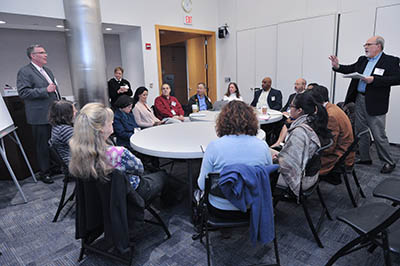Behavioral and Social Sciences Research Festival 2018
Celebrating the Science
Tobacco companies have successfully used direct-to-consumer marketing to entice people to continue smoking or take it up again after they’ve quit. The research that comes to these conclusions—being conducted by Stadtman Investigator Kelvin Choi (National Institute on Minority Health and Health Disparities)—was just one of the many projects highlighted at the NIH Behavioral and Social Sciences Research (BSSR) Festival, held on November 27, 2018.

Kelvin Choi presented his intramural research at the festival.
At the festival, Julia Chen, a postdoctoral fellow in Choi’s lab, reported how Choi’s team analyzes population-based databases to investigate disparities in tobacco use. The researchers found that direct-mail coupons encourage and sustain smoking and disproportionately affect low-income socioeconomic populations (Tob Control, 2018; DOI:10.1136/tobaccocontrol-2018-054363). ]
But now the tables are turned, Chen explained. In a non-NIH study conducted in Minnesota, researchers harnessed direct-to-consumer marketing strategies to encourage healthy behaviors. In the study, low-income smokers responded positively to two strategies—a direct-mail intervention and opportunistic telephone referrals—each offering $20 if they agreed to take part in smoking-cessation counseling. Smoking abstinence rates at follow-up indicated that both strategies had high impact. (Addict Behav 52:1080114, 2016). “Direct-to-consumer marketing works!” proclaimed Chen. Choi’s lab also plans to leverage marketing strategies to promote healthy behaviors.
Other events at the festival included introductory remarks by James Anderson, the director of the Division of Program Coordination, Planning, and Strategic Initiatives; an overview of BSSR research by William Riley, associate director of NIH’s Office Behavioral and Social Sciences Research (OBSSR); a keynote address; other scientific talks; and roundtable discussions.

CREDIT: MARLEEN VAN DEN NESTE
William Riley provided updates on BSSR at the NIH.
Anderson emphasized NIH’s efforts to use big data and machine-learning—or artificial-intelligence—approaches to tackle difficult health-related research and how BSSR is poised to play a critical role in advancing this transdisciplinary area of science. Riley noted a steady increase in NIH funding for BSSR grants over the past five years—approaching $5 billion in FY2018. OBSSR’s co-funding initiative—approximately $20 million annually—provides funding support to the NIH institutes and centers. In 2018, 127 grants were funded, up from 123 grants a year ago. In addition, the OBSSR provides support for the intramural Bench-to-Bedside Program as well as trans-NIH initiatives including the BRAIN Initiative, the Science of Behavior Change program, and the All of Us program.
In her keynote address, economics professor Adriana Lleras-Muney (University of California, Los Angeles) highlighted her research on whether cash transfers to poor families improve children’s education, lifetime incomes, and long-term health. She examined data as far back as 1911 and found that, on average, boys from families accepted into the program lived one to one-and-a-half years longer than those not accepted or those in orphanages and were more likely to attend high school and earn higher incomes as adults.
Scientific sessions focused on basic social and behavioral processes, population and epidemiology research, and intervention research. Mark Jensen (University of Washington in Seattle), who studies cognitive processes in chronic pain, is exploring the differences between cognitive content and cognitive processes and using mindfulness in treating people with lower back pain.
Mauricio Delgado (Rutgers University in New Brunswick, New Jersey) detailed his work on how reminiscing about positive memories buffered the physiological and emotional consequences of acute stress.
Elliot Berkman (University of Oregon in Eugene, Oregon) uses neural imaging to study mechanisms of brain activity and health-behavior change. In one study, he used inhibitory-control training to promote smoking cessation and measured the neural activity of certain brain regions.
Sheri Weiser (University of California at San Francisco) talked about her research on the relationship between food insecurity and poor health, particularly in people with HIV. She found that, in a randomized controlled trial, distributing free meals to HIV-infected individuals improved their nutritional, mental, and behavioral health, thus reducing health-care costs.
Behavioral scientist Marc Adams (Arizona State University in Tempe, Arizona) has examined the influence of built environments for physical-activity interventions.
Jarrad Van Stan (Harvard Medical School, Boston) detailed his research on using ambulatory voice monitoring and biofeedback to improve the effectiveness of voice therapy.
Jeffrey Sparks (Harvard Medical School) presented work from the NIH-funded Personalized Risk Estimator for Rheumatoid Arthritis (RA) Family study (a prospective, randomized controlled trial designed to compare the willingness of first-degree relatives of RA patients to change behaviors). He found that the disclosure of personalized RA risk increased motivation to change RA risk-related behaviors.

CREDIT: MARLEEN VAN DEN NESTE
Festival participants took part in roundtable discussions to advance BSSR.
In the roundtable discussions, festival attendees could choose to participate in one of six small discussion groups to explore such topics as increasing the perceived relevance of BSSR, improving the integration of basic and applied BSSR, and training needs. Participants discussed successes and challenges in each topic and provided suggestions for future directions.
To view a videocast of the festival, which was hosted by OBSSR and the NIH Behavioral and Social Sciences Research Coordinating Committee, go to https://videocast.nih.gov/launch.asp?27206. Event photos are available at https://www.flickr.com/photos/obssr/albums.
This page was last updated on Tuesday, April 5, 2022
